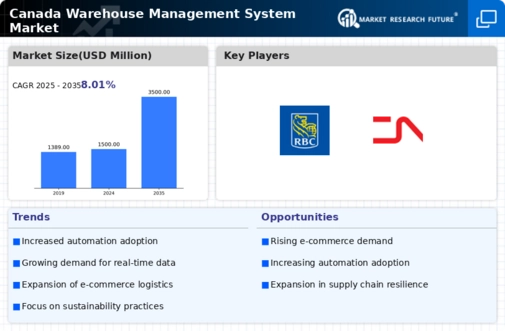Rising Demand for Automation
The warehouse management-system market in Canada experiences a notable surge in demand for automation solutions. As businesses strive to enhance operational efficiency, the integration of automated systems becomes increasingly prevalent. This trend is driven by the need to reduce labor costs and improve accuracy in inventory management. According to recent data, the automation segment is projected to grow at a CAGR of 12% over the next five years. Companies are investing in technologies such as robotics and AI to streamline warehouse operations. This shift towards automation not only optimizes workflows but also addresses labor shortages, making it a critical driver in the warehouse management-system market.
Growth of E-commerce Logistics
The expansion of e-commerce in Canada significantly impacts the warehouse management-system market. With online retail sales projected to reach $50 billion by 2026, logistics and warehousing solutions must adapt to meet the increasing demand for fast and efficient order fulfillment. This growth necessitates advanced warehouse management systems that can handle high volumes of inventory and facilitate quick shipping processes. Companies are increasingly adopting sophisticated software to manage their supply chains effectively. The need for real-time tracking and inventory visibility is paramount, making this a vital driver for the warehouse management-system market in Canada.
Focus on Supply Chain Resilience
In the wake of evolving market dynamics, Canadian businesses are prioritizing supply chain resilience, which significantly influences the warehouse management-system market. Companies are investing in systems that enhance visibility and flexibility within their supply chains. This focus on resilience is driven by the need to mitigate risks associated with disruptions and ensure continuity in operations. As a result, the demand for advanced warehouse management solutions that provide real-time data analytics and inventory management capabilities is on the rise. This trend indicates a shift towards more robust systems that can adapt to changing market conditions, thereby driving growth in the warehouse management-system market.
Increased Investment in Technology
The warehouse management-system market in Canada is witnessing a surge in investment in technology. Businesses are increasingly allocating budgets towards upgrading their warehouse management systems to incorporate cutting-edge technologies. This trend is fueled by the need for improved efficiency, accuracy, and data-driven decision-making. Recent statistics suggest that technology investments in the logistics sector are expected to grow by 15% annually. Companies are focusing on integrating IoT, AI, and machine learning into their operations to enhance productivity. This technological advancement is a key driver for the warehouse management-system market, as it enables businesses to optimize their supply chain processes.
Regulatory Compliance and Standards
The warehouse management-system market in Canada is significantly influenced by regulatory compliance and industry standards. As businesses face increasing scrutiny regarding safety, environmental impact, and operational efficiency, the demand for systems that ensure compliance is rising. Companies are required to adhere to various regulations, which necessitates the implementation of robust warehouse management solutions. This trend is particularly evident in industries such as food and pharmaceuticals, where strict guidelines govern storage and handling practices. The need for compliance-driven systems is a crucial driver for the warehouse management-system market, as it helps businesses mitigate risks and maintain operational integrity.













Leave a Comment